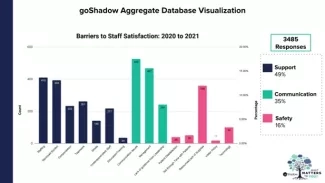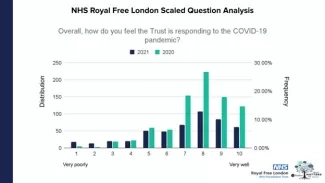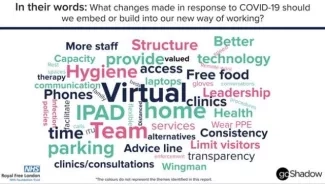Why It Matters
Health care organizations around the world are constantly faced with the difficulties of building and maintaining a culture that supports not only patients, but also point-of-care teams. Uncertainties related to COVID-19 make these challenges harder. Leaders must determine how to keep employees safe, engaged, and supported.
Royal Free London NHS Foundation Trust (RFL), with the support of goShadow, adapted the “What Matters to You?” (WMTY) framework to understand what mattered most to its teams in times of crisis. A series of conversation-based questions and a plan to launch the survey solicited the participation and feedback of all the Trusts’ nearly 15,000 employees. The resulting qualitative and quantitative data was collected during the height of the UK’s first COVID-19 surge in 2020 — while many respondents were under lockdown or redeployed — to identify what was going well, key learnings, and opportunities to improve aspects of safety, culture, and environment. The same process was followed to prepare for the UK’s second surge of COVID-19 in 2021. The survey gathered additional feedback and measured if the changes that senior leaders implemented in response to the 2020 survey added value and resulted in greater satisfaction from the employees’ points of view.
Survey Design
While there are many requests for feedback from NHS employees at a national and local level, senior leaders felt that previous surveys did not gather granular qualitative insights to inform key decisions in the midst of crisis. The WMTY survey contained three types of questions: scaled, ordinal, and qualitative. Scaled questions provide comparable results immediately but no deeper insights. Responses to ordinal questions indicate how respondents prioritize the factors that influence their experience, provide a holistic view of how they perceive their workplace, and suggest how to grow from COVID-19 as an organization. Qualitative questions capture the respondents’ voices and insights in their own words. Our team’s surveying methodology places more emphasis on qualitative responses since they provide thoughtful insights, feedback, and actionable ideas that cannot be gleaned from scaled or ordinal questions.
In 2020, the majority of respondents completed the survey individually, but a small number did so as part of team debriefs. Insights collected from the team debriefs reflected the value of team-based discussion and insights, especially when multiple staffing roles are present and employees feel psychologically safe to participate. This round of findings inspired innovation for the second iteration. In response to staff requests to debrief as individuals and teams, expanded team-based opportunities and themed leadership listening sessions were offered to collect as much data as possible and illuminate employees’ and teams’ voices in April 2021.
The data was collected electronically and analyzed using sentiment analysis and natural language processing to designate domains (Figure 1) and subcategories to represent aggregate qualitative responses. Each response was analyzed, tagged, and labeled as positive, negative, or neutral using a machine learning algorithm. The definitions and sub-categories within each domain were constructed using peer-reviewed resources including the Team Strategies and Tools to Enhance Performance and Patient Safety (STEPPS) curriculum and a literature review of top staff requests and causes of anxiety during COVID-19. The United States Agency for Healthcare Research and Quality (AHRQ) and The United States Department of Defense (DoD) created the STEPPS curriculum as the national standard for team training in health care.

Figure 1. Domains and subcategories used in the analysis of qualitative data
Key Findings
Three primary domains of communication, support, and safety were used to analyze and tag qualitative data from individuals, teams, and listening sessions. This method also allowed for qualitative data to be quantified and compared over time by any demographic, such as role, years of service, department, etc.
Our team has asked employees and patients “What matters to you?” across many organizations. Overwhelmingly, the data is similarly reflective of the aggregate (Figure 2) seen below. More than half of all patient and staff responses identify support (53 percent) as most important to them, followed by communication (27 percent), and safety (16 percent).

Figure 2. Patient and staff responses, categorized into domains of support, communication, and safety, and reflective of sentiment
Upon further analysis, the domains can be broken down further into subcategories representative of employee responses. To learn from employees how to improve at scale, understanding their barriers to satisfaction is pivotal (Figure 3). Our database from 2020 and 2021 finds a similar trend in support (49 percent), communication (35 percent), followed by safety (16 percent). Drilling down into the data revealed that employees want increased staffing and decreased workload to feel supported, improved communication within their team and from management, and more resources and supplies to do their job. Further analyzing employee responses helps prioritize improvement projects, allocate resources, and shows your team that you are listening.

Figure 3. Barriers to staff satisfaction
Royal Free London senior leaders were encouraged by the amount and depth of feedback from employees. In 2020, over 1,000 employees participated in the debrief. In 2021, that number grew to more than 1,200. Both debriefs found that employees’ comments fell most frequently within the domain of support, followed by safety, and communication. Feedback in 2020 and 2021 revealed that employees felt that Royal Free London’s response to COVID-19 (Figures 4 and 5 below) was overall very positive.

Figure 4. Percent distribution of scaled question analysis when employees were asked, “Overall, how do you feel the Trust is responding to the COVID-19 pandemic thus far?”

Figure 5. Percent distribution of scaled question analysis when employees were asked, “How well did you feel the Trust supported you during this time?”
Deeper analysis of open-ended and ordinal responses allowed for employee voices and stories to be revealed and for bright spots to be illuminated. The questions asked of individuals and teams were designed to elicit thoughtful responses that brought individuals and teams together. The survey design allowed for RFL employees to share their recommendations and requests, many of which coalesced around the following themes:
- Share ideas and opportunities for improvement – Staff revealed common pain points and ideas for how to solve them.
- Improve patient experience – Staff elevated the voice of the patient and prioritized innovations to provide person-centered care during a time of crisis with limited visitation and great human loss.
- Reinforce shared values and mission – Examples of how staff found pride and joy, built resilience through their shared experience, and bonded with colleagues and patients who became the “team” that brought them back to work every day.
- Create support and structures to feeling included and heard – Staff emphasized the importance of leaders and managers who foster an inclusive and supportive culture through leader and team-based conversations, rounds, and trainings. These methods made individuals feel valued and prepared to solve the greatest obstacles they faced at the front lines.
The voices of employees were used by the leadership team to choose short and long-term strategic priorities across their multi-hospital system. The aggregate results of the 2020 and 2021 debriefs and corresponding action steps were cascaded to employees to close the loop and to demonstrate that leaders listen, value the voices of staff, and will act upon their recommendations. Leaders have also taken into account what employees identified as sources of pride (Figure 6) and new ways of working post COVID-19 (Figure 7).

Figure 6. Responses of NHS Royal Free London employees displayed in a word cloud when asked, “Tell us what you are proud of personally, as a team or as an organisation?”

Figure 7. Responses of NHS Royal Free London displayed in a word cloud when asked, “What changes made in response to COVID-19 should we embed or build into our new way of working?”
One notable example of how employee feedback has resulted in improvement has been the implementation of Family Liaison and Virtual Visiting Teams in preparation for the second surge of COVID-19 in 2021. Feedback from the 2020 debrief had identified patient and family communication as an opportunity for improvement. Family Liaison and Virtual Visiting Teams communicate with and support point-of-care teams, patients, and families to support virtual visiting. Not only did the Family Liaison and Virtual Visiting Teams allow for more frequent communication with patients and families, but they also helped with some point-of-care teams tasks during a COVID-19 surge. This innovation was so welcomed, employees had suggested in the 2021 debrief that Family Liaison Teams be utilised within the organization beyond COVID-19.
Tips to Get Started
Asking employees “What matters to you?” and other action-oriented questions allows organizations to get to the root of the wants, needs, and desires of employees. Data collected can be cataloged and categorized. Using the voices of those at the point of care, immediate changes can be realized. Innovations to benefit all stakeholders (i.e., Family Liaison and Virtual Visiting Teams) can be implemented. High-impact, high-effort work can be integrated into leader-driven action plans that require more time, coordination, and even culture change (i.e., flexible working arrangements). Importantly, as was ever-present in the Royal Free London Trust, organizational leaders must be devoted to listening to what their teams have to say, putting the data to meaningful use, and closing the loop at all levels of the organization to build teams and trust.
Follow these tips to get started:
- Provide team-based and individual feedback opportunities regularly to drive improvements and create a culture of learning within your organization.
- Share results quickly with your organisation. Identify what changes will be made based on the data collected locally and at scale.
- Ensure action is taken by leaders so that employees know their voices are being used for positive change.
- Download your own baseline WMTY survey to get started.
Angela DeVanney is the founder of goShadow and faculty at IHI. Hannah Hamlin is a project consultant with goShadow and a 2023 Master of Health Administration Candidate at The Ohio State University. Karen Turner is a senior improvement advisor at Royal Free London NHS Foundation Trust.
You may also be interested in:
